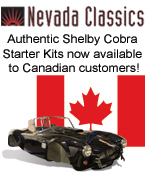 
 Main Menu
Main Menu
|
 Nevada Classics
Nevada Classics
|
 Advertise at CC
Advertise at CC
|
 January 2025
January 2025
|
| S |
M |
T |
W |
T |
F |
S |
| |
|
|
1 |
2 |
3 |
4 |
| 5 |
6 |
7 |
8 |
9 |
10 |
11 |
| 12 |
13 |
14 |
15 |
16 |
17 |
18 |
| 19 |
20 |
21 |
22 |
23 |
24 |
25 |
| 26 |
27 |
28 |
29 |
30 |
31 |
|
|
 CC Advertisers
CC Advertisers
|
|

06-05-2006, 10:39 AM
|
|
CC Member

|
|
|
Join Date: Dec 2001
Location: Louisville,
KY
Cobra Make, Engine: I'm Cobra-less!
Posts: 9,417
|
|

 Not Ranked
Not Ranked

Well, let's see.
You can buy KCR's Stage 2 heads for $2295. They flow....what...about 320 on the intake side? That's completely assembled and ready to bolt on.
A set of bare (without valves or anything) BT's are $1300. Could you unshroud the combustion chamber, mill them down to achieve a decent CR, buy SS valves, locators, seals, springs, retainers, and locks for the difference? And would they flow 320 cfm?
You're looking at say $200 for a set of SS valves, $50 for locators, $25 for seals, $150 for springs, another $150 for retainers, and $25 for locks.
That's about $600.
So we're sitting at $1900 so far....for a head that still doesn't have any machine work done to it...or anything done to it to promote air flow. A guy on the FE forum has a set of untouched BT heads....and they only flowed 267/197 out of the box. That's not much better than the Edelbrock head. So add money to port the heads to put them up to the Stage 2 Edelbrock range.
THEN....you have to buy special stands/rocker arm setups.
Keith uses an awful lot of Edelbrock heads. I think I've heard him mention that he has a CNC program for BT heads...but it requires a lot of machining to get to the point where he can CNC them....
Maybe he'll chime in here.
Last edited by blykins; 06-05-2006 at 10:43 AM..
|
-
Advertising


06-05-2006, 03:06 PM
|
|
CC Member

|
|
|
Join Date: Feb 2006
Cobra Make, Engine:
Posts: 283
|
|

 Not Ranked
Not Ranked

Well, I have more information on the BT heads. The comment given to me was that they are better in every way: flow, combustion, etc. The BT heads flow more at all lifts, and maybe 10% more at high lifts. On an engine, they producted a little more peak, but much more low end.
And that they are more expensive and problematic. Comparing CNCs is different from comparing a stage 2. The CNC cost is maybe a few hundred more for the BT, and the castings are a few hundred more. And of course the Edelbrock has more of an option for using an inexpensive standard head or stage 1 or stage 2 type work.
But that is just the start. They require different rocker stands and different rockers. Both not readily available. The intake will require more porting and some addtional work beyond porting. If you use TD or Jesel rockers, you will need to ensure that a pushrod oil feed is available.
Net, you have to use some more expensive pieces in addition to the heads. My guess is you will spend $2-3k more for an engine using a set of BT heads.

|

06-05-2006, 04:43 PM
|
|
CC Member

|
|
|
Join Date: Feb 2006
Cobra Make, Engine:
Posts: 283
|
|

 Not Ranked
Not Ranked

And back on topic, Genesis says they have 4 customers running the 4.5" stroke. It requires minor clearancing.
They get theirs from Scat or a local supplier with slightly longer lead times but slightly lower prices.
Many people have thought that the 4.5" may not clear the cam without going to smaller rod journals with matching rods, but however it does.
If going with a custom billet crank, going with the smaller rod journals is still an option. It apparently reduces friction and wear and is more than strong enough to handle the loads. Crower, Carrillo, and others can readily build the rods.
And if getting custom rods and custom pistons, you can probably go to a smaller pin....927 or even .866 or .827. This would reduce the piston compression height issues. However, with a 6.7 rod and 10.15 deck height, the 1.2" compression height should be ok.
But to net it out, a 4.31 bore, 4.25 stroke with Edelbrock heads is inexpensive way to build a solid 496 FE. If going bigger, you can get bigger heads and a 547, but will spend $5-10k more.
Last edited by DavidNJ; 06-05-2006 at 04:48 PM..
|

06-05-2006, 05:55 PM
|
|
CC Member

|
|
|
Join Date: Nov 2004
Location: Hillsboro,
OR
Cobra Make, Engine: ERA 541, Shelby 427, TKO600
Posts: 59
|
|

 Not Ranked
Not Ranked
I bought my car complete, so I didn't make the trade offs myself. Mine has an early shelby "turn key" engine (CSX-125). It is a 429 (4.25 bore x 3.78 stroke) with ported shelby heads and intake. I run a pretty mild cam now (230/236 vs 260/260 hyd @0.050) and it pulls down to 1200rpm no problem. The original cam made 500+ HP @6000 RPM on the dyno, so I am not quite at that level with my new cam. But the engine is now very streetable and it seems to rev faster then any V8 I have driven (especially without the little H&S air cleaner/choke removed). I have the rev limiter set for a conservative 5800 rpm and I hit it way too often in 1 and 2nd gear.
If I did it myself I would probably uses a 428 crank (452 cubes) as the cost is essentially the same, but I am not hurting for more power :-) Either way it is all good, great engine.
|

06-05-2006, 06:44 PM
|
|
CC Member

|
|
|
Join Date: Feb 2006
Cobra Make, Engine:
Posts: 283
|
|

 Not Ranked
Not Ranked
Sounds like a good cam choice.
|

06-05-2006, 07:23 PM
|
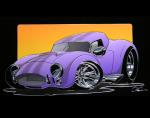 |
CC Member

|
|
|
Join Date: Oct 2004
Location: La Habra Ca.,
Ca
Cobra Make, Engine: Hi Tech Cobra Contemporary Cobra
Posts: 603
|
|

 Not Ranked
Not Ranked
Found out my Dove HiRiser heads were tested and flowed @ 345 intake and 250 exhaust. That was with the manifold bolted on and with a 4" exhaust. These are out of the box #s. Air Research said that cleaned up they will do 365-370 intake 270-275 exhaust. The heads cost me 1800.00 w/o valves. One advantage to Dove's design is their exhaust bolt pattern, Instead of 8 there are 16 bolts on each side. Anyone out there suffering from ill fitting exhaust headers on Alum heads? Just a thought. Michael
__________________
'"An appeal to arms and the God of hosts is all that is left us. But we shall not fight our battle alone. There
is a just God that presides over the destinies of nations. The battle sir, is not to the strong alone. Is life so dear or peace so sweet as to be purchased at the price of chains and slavery? Forbid it almighty God. I know not what course others may take, but as for me, give me liberty, or give me death."' Patrick Henry.
|

06-05-2006, 07:41 PM
|
|
CC Member

|
|
|
Join Date: Aug 2001
Cobra Make, Engine: CSX Cars
Posts: 754
|
|

 Not Ranked
Not Ranked
I have no idea what my bore and stroke is. Somehow it ended up at 472 
__________________
A happy SAI customer
Cobra Make & Engine: Continuation Series Shelby Cobra, CSX 7034 the most accurately detailed Continuation Cobra to original specification since the demise of CSX 4027.
|

06-05-2006, 10:24 PM
|
|
CC Member

|
|
|
Join Date: Feb 2006
Cobra Make, Engine:
Posts: 283
|
|

 Not Ranked
Not Ranked
One important thing to add to the Blue Thunder issues: the exhaust port is raised 4/10ths of an inch. So although it will bolt up, it won't lineup. Pretty much requires a custom header or a modification to the header.
|

06-05-2006, 10:57 PM
|
 |
CC Member

|
|
|
Join Date: Oct 2004
Location: La Habra Ca.,
Ca
Cobra Make, Engine: Hi Tech Cobra Contemporary Cobra
Posts: 603
|
|

 Not Ranked
Not Ranked
David your right and some of Dove's heads have the raised port. I guess people in that mode dont car about spending an extra 4-500 on exhause, but good point. Im in that group but because my heads have 16 bolts instead of 8.
__________________
'"An appeal to arms and the God of hosts is all that is left us. But we shall not fight our battle alone. There
is a just God that presides over the destinies of nations. The battle sir, is not to the strong alone. Is life so dear or peace so sweet as to be purchased at the price of chains and slavery? Forbid it almighty God. I know not what course others may take, but as for me, give me liberty, or give me death."' Patrick Henry.
|

06-08-2006, 01:05 PM
|
 |
CC Member

|
|
|
Join Date: Nov 2003
Location: Fresno,
CA
Cobra Make, Engine: Shelby CSX 4766 (Vegas Built) with 482 Aluminum Pond motor
Posts: 814
|
|

 Not Ranked
Not Ranked
 Well I started with a 427 Center oiler
Well I started with a 427 Center oiler
That was stock stroke. I did not skimp on parts or machine work. And I was well under 10K. But the motor suffered two flat cams. That is when I turned to Craft for a Pond 482 Aluminum short block. Best move I ever made. I still have well under 15 K in my motor but I did the assembly other than the short block. Major difference in feel from a 427 to a 482 motor. Of course the cam can play a major role in that.
__________________
Morgan LeBlanc
Fresno CA
|

06-08-2006, 06:21 PM
|
|
CC Member

|
|
|
Join Date: Jul 2003
Location: West Bloomfield,
MI
Cobra Make, Engine:
Posts: 717
|
|

 Not Ranked
Not Ranked

OK
I've watched, read, listened, and even unknowingly provided a fair amount of the info in this thread. Some info I provided was referenced without crediting the source. Some is right, some is wrong, some is out of context. This is pretty long - but it should be helpful. I apologize in advance for the length.
I built the Engine Masters Challenge 505 FE. Development dyno work was done at Wheel to Wheel Powertrain in Michigan. That work was handicapped by dyno fixture interference that required the headers to be installed upside down and thus block a portion of the exhaust port. With that known limitation we left for the contest with expectations of about 725HP and maybe a bit more with the headers on properly.
It made 752HP at 6300-6400RPM at the contest on Bill Mitchell's dyno on 91 octane. Jon Kaase took that same engine, disassembled it for photography (for his upcoming big block Ford book), and then put the freshened piece on HIS dyno. On Kaase's dyno that same engine made 759HP at 6500RPM. That a reliable backup number in my book.
That motor has out of the box ET CNC ported Blue Thunder head castings, assembled in my shop. I am geographically very close to ET and have a developmental relationship with them on this product. These heads flow at 360 on the intake as tested at ET, with that number verified by both "Birdie" at Flow Technologies, and by Kaase himself. I have not flowed any B-Ts in "as shipped" condition. Since they are designed to be ported such testing is largely irrelevent. The low flowing set referenced in the FE Forum thread were said to have been "butchered" by the person who posted the data.
The development mule for the EMC project was my "other" 505 FE - - the
"675 Horsepower Dinosaur" featured in the July 2004 Hot Rod magazine. That engine is well documented, thoroughly flogged, and had a well developed set of Flow Technology Edelbrocks (around 330). We used it to A-B test parts instead of using up the contest engine. Other changes got us to repeated 689HP pulls. Swapping to CNC BT heads with an intake port match job gave us 30+ lbs/ft. more torque throughout much of the curve, and about 10HP at peak. It also got us 1.7" of vacuum in the intake - - the engine now wanted more air. A Dominator throttle body on an adapter gained us another 13 - ending up at 712HP for a cumulative peak power gain of +/-23HP.
Punchline:
In my opinion, based on my testing, the Blue Thunder heads will make more power than a similarly modified set of Edelbrocks. The Edelbrock assemblies, with 2.09 and single springs, are nice for a driver but not useful in this context. Edelbrock bare castings are around $1000 - - the B-Ts around $1400. The CNC program is around $1500 for the B-T vs. $1350 for Ebrocks. Valves, springs, etc. are the same. The B-T requires high riser stands - - we fabricated our own at a street cost of roughly $350. Standard rockers and shafts will work - - so total added cost to go B-T is $900 comparing apples to apples. Using the added B-T fastener locations and the available T&D setup will provide a far more robust max effort race valvetrain package than is possible with any Edelbrock based combination.
The intake manifold port mods req'd are within the skill range of an experienced hobbiest, port work and pushrod tubes are also common to highly modified Edelbrock heads. The added .400 in exhaust port height may be an issue for some - but I was able to install the BT equipped engine into my '69 Torino with minor denting on a set of shelf Hookers - - they required some denting with the Edelbrocks too. Your hammerring may differ. Detail data and images of the CNC B-T heads are readily available on my web site.
Last edited by Barry_R; 06-08-2006 at 07:21 PM..
|

06-08-2006, 07:38 PM
|
|
CC Member

|
|
|
Join Date: Feb 2006
Cobra Make, Engine:
Posts: 283
|
|

 Not Ranked
Not Ranked
Nice post Barry. I referenced your shop in a post before we talked. Because I may include an error or misrepresentation, I typically don't reference conversations. Many times I also combine sources. My first BT comment was from ET directly. Clearly, the info is always better from the horse's mouth.
I believe I compared 'Stage 1' and 'Stage 2' numbers to get the $2k to $4k range, plus the cost of the T&Ds vs. a Sig Erson or Harland Sharp on the Edelbrocks. Can you really install the BTs for only $900 more?
Keith Craft's site says he has Edelbrock CNC programs up to 375 cfm, which is more than ET claims for their CNC. His assembled 'Stage 3; heads are $2995. His 'Stage 2' is rated at 330 cfm for $2295.
Last edited by DavidNJ; 06-08-2006 at 07:47 PM..
|

06-09-2006, 06:02 AM
|
|
CC Member

|
|
|
Join Date: Jul 2003
Location: West Bloomfield,
MI
Cobra Make, Engine:
Posts: 717
|
|

 Not Ranked
Not Ranked

David,
No problem - just noticed that the thread had drifted with some data falling off from factual into conjecture. I generally lurk on this forum - knowing that some very talented builders (such as Keith and George) have made a significant financial investment here - and I am not yet in a position to do so. Both of them are good folks, have well deserved excellent reputations, and appear to treat their customers well. My fledgling operation is more parts sales oriented - - but I certainly enjoy a limited degree of competition 
Keith's flow data must be compared to other parts on his bench - as should my current range of ET ported stuff be compared to other parts on our bench. Please note that I always reference multiple corrobarating(sp?) sources when possible. That is because flow numbers - like dyno numbers - will vary from location to location and operator to operator. Dynos and flow benches are excellent directional tools - - but they are not the sole predictors of an engine's performance in the car. There is so much more involved - but the numbers are lots of fun to talk about...
Since I am "in" on this thread I may as well toss a couple opinions out as well. These are opinions - - not hard facts...
As to bore - - bigger is better as long as there are airflow limitations. Once you are flowing air at or beyond the engine's needs ther are no further advantages to larger bore - - except for ring friction.
As to stroke - - more is better until the rules guys throw you out. Except for that friction thing. Ring friction increases with RPM (simple factor of distance traveled). More displacement outweighs friction - - see rules comment.
Bore/stroke relationship - - I consider this as an output and not a number to work towards or design for. I'd rather go for as much bore as the engine/airflow needs/wallet allows - - stroke to whaever the rules/wallet permits.
Weight - - I need to lose ten pounds. Piston weight is really only significant in that lighter parts will allow more RPM before failure. RPM is power, but if you don't need more RPM spend your money elsewhere. Unless you are running NHRA Comp Eliminator or F1 unloaded RPM gain rate (i.e. blipping the throttle) means very little once your in gear. Inertial gains are real, but very, very small in proportion to other things.
As to rod length my thoughts mirror those of the guys at Reher-Morrison. I select the stroke, design the piston as far as desired ring pack, pin size and skirt without punching through the oil groove - - and choose the rod that fits. When working with common available rods, the pin height will change to get something "off the shelf" - I don't attach any religion to ratios at all (within rational ranges - no 5.090 rods and 3" compression distances..). My preferred compression distance is somewhere between 1.25 and 1.35 - - a range which delivers plenty of real estate for rings and a nice stable skirt package for bore stability. I would trade a shorter rod to gain a better and more stable ring pack in a minute.

|

06-09-2006, 07:47 AM
|
|
CC Member

|
|
|
Join Date: Feb 2006
Cobra Make, Engine:
Posts: 283
|
|

 Not Ranked
Not Ranked
If going 'custom', the lighter piston/pin weight would make a smaller rod journal/cap/bolt possible, or at least safer.
Also, Big block stuff can be heavy so there is more weight to save; maybe 300-500gm vs 100-150gm in a small block. And the high power can result in high engine acceleration rates (> 600rpm/sec). So the lighter stuff can add 5-10lbf-ft torque and 10-15hp from lower inertia. More than a small block.
Barry, since your a ring guy (I believe Barry was the top guy at one of the major manufacturers), what about the LS1s using 1.115" comp heights on all their 4" stroke stuff? What would your recommended ring package be, in terms of ring size, ring spacing, tension, and gas porting?
Note: my power estimates are from calculations and not dyno tests.
Last edited by DavidNJ; 06-09-2006 at 08:05 AM..
|

06-26-2006, 03:14 PM
|
|
CC Member

|
|
|
Join Date: Nov 2002
Location: Cupertino,
CA
Cobra Make, Engine: Contemporary Classic CCX 3970: 1965 427 Cobra S/C, Shelby aluminum 427 CSX 290 (468 cu in) engine
Posts: 789
|
|

 Not Ranked
Not Ranked

I'll try to answer your questions in order, Rob:
I chose a 4.250" bore, 4.125" stroke (468 cu in) engine that develops 558 HP @ 6,000 RPM and 535 lb-ft of torque at 5,000 RPM.
The torque curve rises fairly rapidly from 2,000 to 3,000 RPM is fairly flat after that. Not a ton of torque at at 1,500 RPM, but enough to get under way smoothly. *Lots* of push from 3K+ RPM  and it gets 515 lb-ft of torque at 4,000 RPM.
Shelby ordered the crank from LAE PANKL(?), material type: EN30B.
The engine was fairly easy to get, as it was already built for another customer. The hard part was cutting the check.
I'm pretty satisfied with the engine (other that the fairly standard rear main seal leak), and the 10.7:1 compression ratio. I was assured that it would run fine on pump gasoline (91 Octane locally), and that just isn't so. I add Amsoil Series 2000 Octane Boost, but still need to use my clutch to shut the engine down. I would go with just under 10:1 next time. Also, I went with the stroker because there was no charge for it. Otherwise, I would've gone with the standard 427 cu in. But my engine runs good and sounds simply marvelous!  Rich

|

06-26-2006, 05:23 PM
|
|
CC Member

|
|
|
Join Date: Feb 2006
Cobra Make, Engine:
Posts: 283
|
|

 Not Ranked
Not Ranked
An LAE EN30B is a top of the line crank.
It won't shut off? What heads, cam, intake, and carb are you running?
|

06-26-2006, 08:47 PM
|
|
CC Member

|
|
|
Join Date: Nov 2002
Location: Cupertino,
CA
Cobra Make, Engine: Contemporary Classic CCX 3970: 1965 427 Cobra S/C, Shelby aluminum 427 CSX 290 (468 cu in) engine
Posts: 789
|
|

 Not Ranked
Not Ranked
David: When I decided on the Shelby engine, I figured all the components would be top notch. Thanks for the confirmation on the crank. I am running Shelby heads (82 cc); a Crower 297HDP hydraulic camshaft (intake duration: 298º with .590" lift, exhaust duration: 308º with .588" lift); Shelby medium riser dual plane intake manifold and Holley 850 carburetor with vacuum secondaries. I think the dieseling problem  is the combination of too much compression with crappy gas, but if you have any other suggestions, I am open to suggestions. When the 85% ethanol blend is available out here, I will be the first Cobra in line. After a little conversion work, that is. No one said it was going to be easy. Rich |

06-26-2006, 09:57 PM
|
|
CC Member

|
|
|
Join Date: Feb 2006
Cobra Make, Engine:
Posts: 283
|
|

 Not Ranked
Not Ranked
Too lean, wrong plugs, incorrect idle adjustment...after that it gets nasty...too rich that caused carbon build up, sharp edges in the combustion chamber, etc,
LAE is LA Enterprises, E30B is an British spec with no AISI equivalent...somewhat higher yield and tensile strength than than 4340 or 300M.
Last edited by DavidNJ; 06-26-2006 at 10:03 PM..
|

06-27-2006, 05:39 AM
|
|
CC Member

|
|
|
Join Date: Dec 2001
Location: Louisville,
KY
Cobra Make, Engine: I'm Cobra-less!
Posts: 9,417
|
|

 Not Ranked
Not Ranked
Rich, try idling your engine down and see if that helps the run-on problem......
What's it idling at now?
|

06-27-2006, 11:20 AM
|
|
CC Member

|
|
|
Join Date: Nov 2002
Location: Cupertino,
CA
Cobra Make, Engine: Contemporary Classic CCX 3970: 1965 427 Cobra S/C, Shelby aluminum 427 CSX 290 (468 cu in) engine
Posts: 789
|
|

 Not Ranked
Not Ranked
Thanks gents, for your comments. I have fine tuned the carburetor on a chassis dyno and it idles about 1,000 RPM (my genuine Smiths tach doesn't read that low);  rough idle when it is cold, but smooths out a bit when it warms up. I would have trouble keeping it running if I slowed the idle down. I'm using the plugs Shelby gave me, Champion RN7YC, and they appear to be OK. As far as sharp edges in the combustion chambers, etc., I have no idea, but would be very surprised and disappointed to find anything like that. I've been told by some experienced folks that this is a common problem with compression ratios over 10:1, so I think I am just going to live with it. Shutting the beast down with the clutch is almost automatic now anyway. But I am still waiting for the first E85 fuel to be available in my neighborhood and all this run-on stuff will be a thing of the past. Rich |
 Posting Rules
Posting Rules
|
You may not post new threads
You may not post replies
You may not post attachments
You may not edit your posts
HTML code is Off
|
|
|
All times are GMT -7. The time now is 02:39 PM.
|

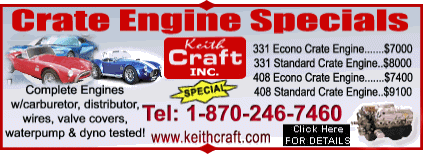


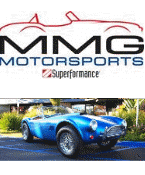
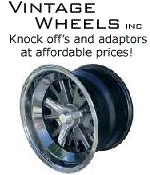

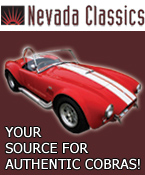

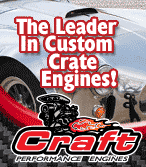
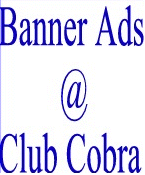
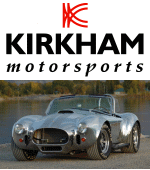

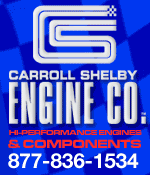









 and it gets 515 lb-ft of torque at 4,000 RPM.
and it gets 515 lb-ft of torque at 4,000 RPM.  Rich
Rich is the combination of too much compression with crappy gas, but if you have any other suggestions, I am open to suggestions. When the 85% ethanol blend is available out here, I will be the first Cobra in line. After a little conversion work, that is. No one said it was going to be easy. Rich
is the combination of too much compression with crappy gas, but if you have any other suggestions, I am open to suggestions. When the 85% ethanol blend is available out here, I will be the first Cobra in line. After a little conversion work, that is. No one said it was going to be easy. Rich Linear Mode
Linear Mode



